5 Challenging the Ammo Companies from Grass Roots [Mai]
Student Learning Objectives
1) The student will learn the 2nd
2) The student will learn the major influences that resulted in the modern guns and ammunition we enjoy today.
3) The student is encouraged to gain further study to understand how guns helped develop the United States, how guns protect the other amendments outlined in the bill of rights and keep and protect the Constitution of the United States of America.
Introduction
The Constitution of United States of America 1791 (rev. 1992) Amendment II states explicitly: A well-regulated Militia, being necessary to the security of a Free State, the right of the people to keep and bear Arms, shall not be Infringed. (Madison, 1791) [1]
The wording leaves plenty of room for legal and political wrangling over the meaning of words like “well regulated,” “militia,” “right,” “people,” “keep,” “bear” and “arms.” (Ingraham, 2016) It does not leave room for any abridgement of the word Infringed.
The term ‘Arms’ in the ‘Second’ Amendment refers to weapons. The cutting-edge technology for weapons when the Amendment II was written, would have been the Revolution War era smoothbore musket (Figure 5.1):
Figure 5.1 American Revolution War era Smoothbore Musket
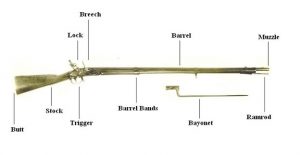
Source: (Ingraham, 2016)
Without gunpowder and bullets, a smoothbore musket was and is nothing more than a fancy walking stick or at best an artifact of history. This fact still relevant today. The relationship between gunpowder, bullets and their corresponding firearms/weapons/guns/arms is as intimate relationship as they come. One without the other, the guns and bullets intended function cease to exist and operate as they were designed. “….a musket is a smoothbore weapon much like a 12-gauge shotgun.” (Harrington, 2013)
Few things have changed the world as much as when humans learned to harness the power of gunpowder. Gunpowder in its earliest form, was not called, ‘Black Powder’, until an early version of smokeless power was invented. At that time, it became known as ‘Black Powder’. At the time of original discovery, it was black in color. Gunpowder was first thought to be discovered by the Chinese, they learned to use hollow tubes with gunpowder and projectiles to harness its power for something different than fireworks. Black powder formula in its purest variant is synthesized as Potassium Nitrate (saltpeter) 75%, Carbon (in the form of charcoal) 15%, and Sulfur 10% See Figure 5.2. (Wallace, 2018)
 +
+  +
+ 
Figure 5.2 Gunpowder Composition
Source: (Wallace, 2018)
There have been many iterations in the development of guns, propellants, and bullets. The development and improvement of these three basics tend to occur within relative similar time frames. Guns over time have become more reliable and able to deliver multiple shots/rounds/bullets/projectiles in a shorter time. Black powder was the initial propellant of a bullet/projectile. As guns evolved, their propellants and bullets/projectile evolved with them and were dependent on gun evolution.
Relevant History – From Muzzle loaders to Modern Cartridges
The first useable guns started as a Matchlock (Figure 5.3) where a burning wick, typically made from hemp, was triggered to ignite a small amount of powder in a flash pan.
Figure 5.3 Match-Lock musket
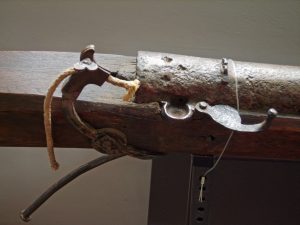
Source: (Kolander, 2016)
This was difficult to control with a burning wick, which was not much more than a small burning piece of rope that maintained a hot ember. In an effort to eliminate the use of a burning rope, a wheel lock was designed to create a rotational force that created a spark. The wheel would be wound with a crank then released upon a pull of the trigger. The unwinding motion would create sparks and igniting the powder in the open pan (See Figure 5.4) .
Figure 5.4 Wheel-Lock
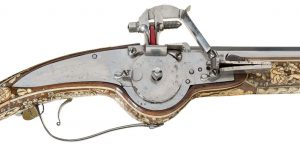
Source: (Kolander, 2016)
This method was better due to elimination of the burning rope! However, being mechanical it was not without design problems and the open flash pan was still exposed and vulnerable to environmental moisture. (Kolander, 2016) The next most successful design was based on a piece of shaped flint-rock that was held in the jaws of a hammer. It would strike an extension, “Frizzen,” on a flash pan cover.
Figure 5.5 Flint-Lock
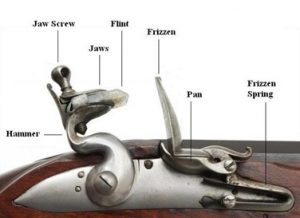
Source: (Kolander, 2016)
This design (Flint-Lock shown in Figure 5.4) covered the vulnerable gunpowder laying in the flash pan until the trigger was pulled allowing the flint to strike the Frizzen on the flash pan cover. That action forced the Frizzen out of the way and expose the gunpowder in the pan, allowing it to be ignited. It allowed for no burning rope and the spark created was relayed to the gunpowder being protected from moisture or spillage until an instant before firing. (Author, 2020) The gun was placed in halfcocked position while the flash pan was being loaded with powder. This design feature was to allow the operator to perform the pan loading procedure while not being in a fully cocked position, supposedly safer. However, sometimes the operator would set off the trigger in the halfcocked position either by accident or poor design. This is where we get the saying, ‘Don’t go off halfcocked!’ (Martin, 1761 (first Citation) 2021)
The initial, and up to this point, guns were considered muzzle loaders and their barrels were smoothbore. Muzzle loaders were loaded from the end of the barrel or what is commonly called the business end. Here are the loading steps for muzzle loaders (Figure 5.6):
- Ø 1&2) a metered amount of gunpowder was first inserted into the muzzle end.
- Ø 3-7) a cotton wad with a round lead ball was inserted and tamped in the gun barrel until properly compacted.
- Ø 8&9) before being able to be fired, a small amount of gunpowder was then placed into the flash pan.
- Ø 10) Eventually, a percussion cap was developed, which sped up the operation. If everything had been done properly, the gun was ready to fire once the trigger was placed into the fully cocked position.
Figure 5.6 Loading Steps of a Muzzle loader
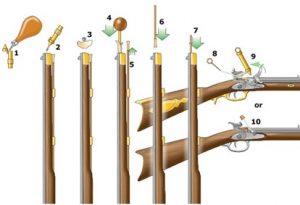
Source: (Martin, 1761 (first Citation) 2021)
Figure 5.7 Bullet position in a Muzzle loaded gun
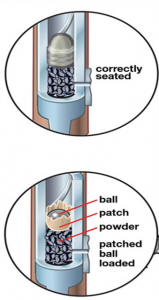
Source: (Youtube, 2021)
You can see how the ball in the lower portion of Figure 5.7 is positioned after loading. The upper portion of Figure 5.7 shows the bullet design after the round ball. Even though, it was called the mini-ball, it looked nothing like the earlier round ball. What the mini-ball did was capture all the escaping gases from the barrel. This increased muzzle velocity, distance, and accuracy. However, that caused the pressures within the barrel to increase which demanded that increased strength within the metallurgy of the barrel had to be increased. You can almost say that ammunition design and gun design became like a dog chasing its tail. An improvement forced and improvement in the other.
Eventually, breech loading guns were designed so that the powder and bullet could be loaded from the breech end. Several things had to come together to allow this to happen. The breech loading gun design had to be worked out at the same time as the cartridge had to be invented. The two were reliant upon each other.Early cartridges had a paper wrapped charge of powder and a mini-ball incorporated into the pre-assembled bullet or round. A round in the world of guns is considered to be a single bullet or called a shot. Many of the terms relating to guns and ammunitions become interchangeable and are usually familiar to the user or in this case the shooter.
Figure 5.8 Bullet design progression
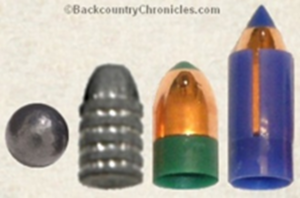
Source: (BackCountry Chronicles , n.d.)
Figure 5.8 shows how the bullet progressed in design. Muzzle loaded bullets and muzzle loaded guns are still used today.
The first paper cartridges to include the bullet and placed into the breech were quickly replace with a canister called a shell or brass cartridge. A cartridge can be called a shell and vs. versa. A bullet can be called a shell, cartridge or a shell and ammunition. The context the words are used in are important. As the paper cartridge came into its existence breech loading guns became better.
Figure 5.9 Paper cartridge used in early breech loading guns

Source: (contributors, Paper cartridge, 2021)
Figure 5.10 Early breech loader w/ fitted cartridge
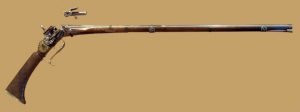
Source: (contributors, Breechloader, 2021)
The above Figure 5.10 was a very early breech loading design. The actual cartridge was loaded much like that of the earlier muzzle loaders. However, the loading of the cartridge was then entered into the breech end of the gun.
Eventually, the paper cartridge led to advent of the metallic cased gunpowder and bullet. See Figure 5.11.
Figure 5.11 Bullets w/ brass casing
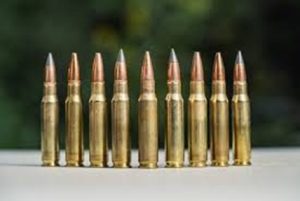
Source: (Jeff, 2020)
Figure 5.12 Metallic cased bullet in chamber of breech loaded gun
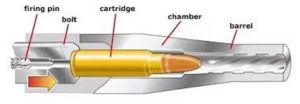
Source: (II, 2017)
Figure 5.13 Rifled barrel
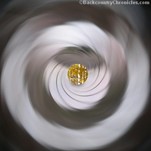
Source: (BackCountry Chronicles , n.d.)
Figure 5.14 Black powder
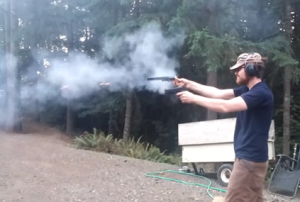
Source: (YouTube, 2021)
Figure 5.15 Smokeless Powder
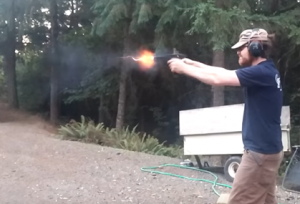
Source: (YouTube, 2021)
Several events came together to make a more powerful, accurate, reliable, and easier to use gun. Those events included: Preassembled metallic case shell (see Figure 5.11), Breech loading gun (see Figure 5.10 & 12), Smokeless powder (see Figure 5.14 & 15), improved metallurgy, gas operated case extraction and rechambering (see Figure 5. 16), center fire ammunition (see Figure 5. 16), Barrel rifling (see Figure 5.13). This discussion is by no means an all-inclusive recreation of the history of firearms and ammunition, only the highlights that made major shifts in the trajectory of guns and ammunition outcome are pointed out here.
Figure 5.16 Rim fire vs Center fire
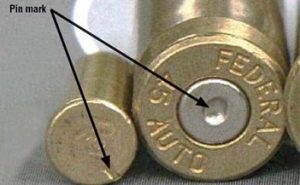
Source: (SIMMONS, 2020)
Figure 5.17 Shell ejection and reloading using excess gas
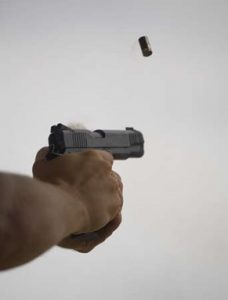
Source: (Sagi, 2021)
Summary
To reach the technology of modern weapons (see Figure 5.17), it was important that a smokeless power was developed. The smokeless powders do not only give us less smoke but also greater chamber pressures that could push a soft metal such as lead through a rifled barrel that had no leakage around the bullet. The rifling spins the bullet giving it greater accuracy but also requiring higher chamber pressures to push it through the barrel that was fit so tightly. Only a shell that houses its propellant and bullet could assist with the tight fit. It also allowed for ease of loading and once the round was expended a grove at the base of the shell could be gripped by an extractor that is powered by some of the excess gas of the spent round to automatically remove the spent shell casing. This action was important to take place at the breech and is why breech loading designs became so very important to the semi-automatic weapons we see today. The early smokeless powder was from a nitrocellulose and nitroglycerin mix that gave less smoke, higher chamber pressure, by complete combustion and left less corrosive remains since it was mostly consumed, unlike Black powder that would not work in today’s guns.
Figure 5.18 Modern AR-15 photo courtesy of Randall Mai
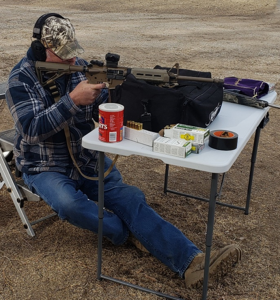
Today’s shooters are typically more informed than ever before. Many hold conceal/carry licenses, have taken hunter safety courses, abide by all laws and regulations, some belong to hunting clubs where ideas and understand is shared and peer reviewed. Their reasons for owning and shooting guns vary from sport/target shooting, personal protection, game hunting to provide food for their families. Today’s shooters understand the need to practice because shooting is a perishable skill and the need to be familiar with their gun is a must. This should be understood then that a gun owner will not buy a gun to put in a box unless they intend act as a collector. Just like a pilot that flies, a gun owner must practice. That being said, ammunition will be consumed on a regular basis; therefore, there is a continual need to replace a gun owner’s ammunition stock.
The Nub – Ammunition shortages and government suppression of stocks
At the start of this writing there was rationing of ammunition and complete shortages. The next section was happening just 20 hrs. while these very words being typed:
[OREM, Utah — an amazing sight outside a Utah County gun store as hundreds lined up to buy ammo.
The line stretched around Gunnies, located at 396 South State Street in Orem, all throughout the day on Saturday.
Some traveled as far as Kamas to wait for hours in the cold.
KSL-TV spoke to a number of people — some said they came for the restocked ammo; others were more anxious. They mentioned current political events — the GA runoff, a soon-to-be transfer of power and Wednesday’s violence at the U.S. Capitol. Many in line also yelled out: “Biden is going to take our guns.”
“There were people down here, 200 lined up before the store opened,” said gun owner Mark Greer who drove from South Jordan.
Recently, there has been a shortage on the most popular ammo.
“It goes fast because there’s none out there,” said Greer.
The ammunition shortage started in late spring of 2020 when the coronavirus altered manufacturing.
Ammo has been on and off shelves, but Gunnies restocked its AR-15 ammo supply on Saturday.
“Perfect storm for gun supply,” said gun salesman Chris Hansen.
The masses came to get their hands-on part of that shipment.
One Gunnies employee couldn’t get the ammo on shelves fast enough.
“This case has 1,000 rounds,” said the worker. “I have gone through 10 boxes already in two hours.”
Because the store has seen hoarding in the past, there was a limit placed on what a customer could buy.
“On this 223-556 that we got in that everybody’s here for today, we’re allowing 200 rounds per customer,” said Hansen.
Gunnies sales reps said they have seen some of their busiest days ever this year, adding that the shop is not usually busy like this in January.
“We have seen a rush on guns and ammo before – but never in January,” said Hansen. “Typically, after Christmas it slows down, but this year has been just the opposite.”
They mentioned that when Obama was elected in 2008 and again in 2012, there was a run-on guns and ammo.
Those in line expressed different reasons for showing up.
“With the changes coming of a new Presidential Administration, people are concerned about their 2nd Amendment rights,” said Greer. “That’s why you see so many here today.”
“People are coming in and they are pretty scared. They feel they are being attacked,” said Gunnies employee Josh Hansen. “They feel the need to fight back, or at least protect themselves.” ] (Tait, 2021)
According to United States Government Experts, any proposed amendment to the Constitution needs to be passed by both the House and the Senate, with two-thirds majorities. It would then need to be ratified by three-fourths of the 50 states, or 38 of them. Historically, that’s proved unlikely and challenging. In the history of the United States, the only amendment that’s ever been repealed is Prohibition. (Tait, 2021)
So, what is happening? With close to 8 million new gun owners there is no doubt that there is increased demand on the ammunitions supply chain. But why are there so many new gun owners? Is it because of the individuals wanting to impose gun control on the nation? Is it because of the riots of 2020 in the Portland area? Is because of the worries of the pandemic of 2019? The pandemic did create the toilet paper shortages, but they rebounded quickly. You cannot go to any of the stores and find ammunition. Even though the manufactures claim they have increased production.
One more little item almost 7+ years old and no one really took notice.
“The Denver Post, on February 15th, ran an Associated Press article entitled Homeland Security aims to buy 1.6b rounds of ammo, so far, to little notice. It confirmed that the Department of Homeland Security has issued an open purchase order for 1.6 billion rounds of ammunition. As reported elsewhere, some of this purchase order is for hollow-point rounds, forbidden by international law for use in war, along with a frightening amount specialized for snipers. Also reported elsewhere, at the height of the Iraq War the Army was expending less than 6 million rounds a month. Therefore 1.6 billion rounds would be enough to sustain a hot war for 20+ years. In America.” (Benko, 2013) The interesting question to ponder is how much more ammo has been purchased since 2013 for DHS “practice?”
Figure 5.19 Empty shelves at a local gun store courtesy of Randall Mai
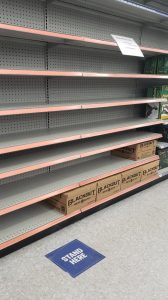
Figure 5.20 online buying Courtesy of Randall Mai
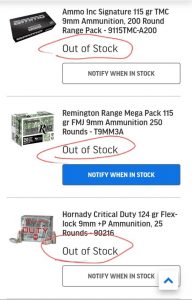
It is possible that hording, scalping, increased demand, fear buying will throw off the normal supply and demand. However, every caliber of ammunition and most of the guns are gone. It starts to make a person wonder if there is more at play. Especially when the incoming president says he is coming for people’s guns. It should be noted that the 2nd Amendment is considered a right from God and not given to people by the government. But it is considered to be protected by the government, as it says, ‘…shall not be infringed!’ This may be true but by not supplying ammunition to the public has the same effect as disarming the American public and as stated at the start of this chapter, without ammunition, a gun is nothing more than a stick. Some gun owners have resigned themselves to reloading their own ammunition. But stores do not have reloading supplies. It is a little ironic that it’s not just the popular calibers no components are available to reload but ever caliber has NO supply. That makes no sense!! Every re-loader will tell that they do not have the apparatuses to reload all calibers across the caliber spectrum. It makes no economic sense and would simply not be cost effective. Another red flag!
Ammunition – Like water in an ocean, everywhere but not a drop to drink
What do gun owners do for ammunition? Let’s take a look at what other authors are saying: Ammunition purchasers across America—or make that would-be purchasers in record numbers—are finding shelves bare, and unfortunately that’s hardly breaking news. If this were simply a Christmas-season run, we could insert a Grinch joke here and assume things would return to normal after the holidays. But, in fact, this shortage, as many readers can attest, traces back at least to spring when COVID mania shocked the country and has since intensified under an unprecedented chain of cultural phenomena. Many gun owners feel that the only way to ensure they have ammo when they need it is to buy in bigger-than-normal quantities, and the result is hoarding.
As detailed in a recent “Keefe Report,” nearly any caliber that’ll go bang in whatever quantity is up for grabs is snapped up almost immediately. (Keefe, 2020) Consumer frustration is rampant, and there’s a real concern about personal- and home-defense shooters not being able to get ammo they need to be prepared.
Anyone who’s been a gun owner and at least a semi-active shooter going back a decade can remember earlier shortages, and while those were truly galling and nationwide, this one’s different. It’s even more widespread and more pervasive in terms of unattainable calibers—nearly all of them, from what we’re hearing. Like that other lingering current event on everyone’s mind, we’re left wondering: When it will end?
That question is landing in record numbers, too, in the inboxes, customer-help lines and direct attention of nearly everyone working for America’s ammunition manufacturers. We talked to a few key executives who spoke about the inquiries and criticism coming their way—so much of it that, at times, it threatens to impede normal operations—and who shared anecdotal requests that would be comical if the shortage weren’t so serious. They were also frank in answering the question about when relief will come, and while there are bits of good news, the outlook for returning to normal supply-and-demand in 2021 remains murky. (Zent, 2020)
Let’s Listen to the Manufactures (See Table 5.1) : (Zent, 2020)
Table 5.1 Listen to the Manufacturer’s
| Hornady – Jason Hornady | “Ammunition is the new toilet paper…… |
| “The big problem here-we’ve seen it before, but not like this- is folk’s panic thinking they won’t be able to get any more and so buy more than normal… | |
| “We make it one day and ship it the next.” | |
| “I’ve seen shortages six times in my career,” said Hornady, “but the difference this time is the string of events—Walmart, Virginia [anti-gun legislature], coronavirus, riots, an influx of [6-7 million] new gun owners, a bad election. |
| Vista Outdoor – Chris Metz | “After seeing big sales spike as a result of COVID, civil unrest and then so many more people getting out this year going hunting – license sales are up like crazy…… |
| “But ever since Joe Biden was named the presumed presidential-election winner, we have seen a reaction in the marketplace, and it hasn’t subsided… | |
| “Demand has been strong across the board—any type or caliber of handgun ammo; small rifle, big rifle, hunting rifle; even rim-fire—all of it really picked up. |
“We make it one day and ship it the next.” “We talk to a big database of users on a monthly basis, and one thing we’re noting is that what we call ‘heavy shooters,’ those who shoot 10,000 rounds or more per year, a lot of them haven’t been purchasing. They’ve seen the frenzied activity and are holding back in hopes it’ll subside. Well, we all know what’s going to happen when they work through their stockpiles and at some point, come back to the market. So, no, we don’t foresee any slowdown in the demand in 2021.”Jason Hornady vowed his company is doing everything it can to meet that demand but not without concerns. “Our workforce has pushed hard through this but is fatigued. We have an issue finding people to keep the machines running, and trust me, everyone is working a lot of hours,” he said. “I was in a camp back in September where someone commented that such-and-such gun company was ‘shipping only 20 percent more than last year’ and that ‘they just don’t care about making more.’ Please. There’s no factory of any kind that doesn’t want to make as much as they possibly can. That’s us. We’re doing as much, making as much as we can,’ said Hornady. “For 2020, we’ve shipped 30 percent more than we did a year ago. We are adding capacity, but according to an existing plan.
“I’ve seen shortages six times in my career,” said Hornady, “but the difference this time is the string of events—Walmart, Virginia [anti-gun legislature], coronavirus, riots, an influx of [6-7 million] new gun owners, a bad election. It all adds up. Right then, hunting season comes along, and you know what consumer is the maddest? The ones who normally buy two boxes of deer ammo a year. They go into their local gun shops and can’t believe [the shelves are bare]. Our local gun-store owner called to tell me about two guys who came into his place looking for hunting ammunition, and then they told him that Hornady has been shut down since June. Crazy!(Zent, 2020)
“At the same time, COVID is a reality for us, too,” said Hornady. “If an employee has to quarantine, even if they’re not sick, we can’t just send a loading press home with them. We’ve had to spread out and guard against super-spreader events so that it won’t shut down a big part of the factory.”
Both industry leaders cited shortage of raw materials as a concern, too. Hornady said his firm laid in a “… six-month supply at the first signs of how serious COVID might be. We’re grateful that we did, but when you have a six months’ worth of material, you also have a space problem. And not just copper and lead, it’s also packaging, staples and other supplies. Did you know there’s a shortage on the DOT-approved cardboard required for shipping our loaded ammunition? We’re now having to ship in white boxes instead of brown ones because we can get more of that.”
Chris Metz echoed that, saying it’s been challenging for his ammunition brands—Federal, Speer and CCI to keep enough brass and primers on hand, despite the fact that Federal and CCI are two of the world’s biggest primer manufacturers.
The same has been true for Vista’s newest brand, Remington Ammunition, which the outdoor conglomerate acquired in September. “Both the workers at Remington and those of us from Vista see this as a marriage made in heaven,” said Metz. “And it couldn’t have come at a better time from a capacity standpoint. That factory wasn’t working, which contributed to the shortages.” The high-production facility in Lonoke, Ark., which for decades has produced the familiar green-and-yellow-boxed ammunition, is ramping up this month, offering one glimmer of hope that the supply side will be buoyed.(Zent, 2020)
“We’ve been working to rehire 400 to 600 furloughed workers, have been retraining them and getting the manufacturing processes back in place,” reported Metz. “Supplies of Remington ammunition should be coming back on the market in early January. We all grew up with the brand, we love it, and we know we’re not alone.”
It will also be interesting to see if some of the other names in U.S. ammunition manufacturing are able to step up production on the heels of developments in this pivotal industry segment. SIG Sauer, for one, is operating an ultra-modern plant in Jacksonville, Ark., and its loads have gained traction with several gun-owner segments.
Sierra Bullets began selling its own branded cartridge a few years back, primarily hunting rifle cartridges, but the company made a strong growth statement when it acquired Barnes Bullets during the Remington Outdoor Corp asset sell-off in late September. The Barnes installation in Mona, Utah, while not as large as the legacy brands’ plants, has a history of producing a full range of highly regarded rifle and pistol ammo, and now that it’s out from under the Remington corporate umbrella, is expected to again contribute more to the national supply chain.(Zent, 2020)
A third maker that bears watching is Fiocchi USA, which announced in July that it will be expanding its stateside manufacturing by adding a facility in Little Rock, Ark., to supplement an existing plant in Missouri. Expect to see an expansion in domestic-made Fiocchi product lines, which produces top-quality rifle, pistol and shotshell products. Furthermore, Fiocchi announced it has acquired Baschieri & Pellagri, who’s high-end shotshells are the gold standard for many European clay’s competitors and hunters, and they too will be produced in the United States.
When contacted, a spokesman for the Winchester and Browning ammunition brands simply commented: “Like many manufacturers in the shooting-sports industry, we are experiencing extremely high demand for our products. We are continuing to manufacture and ship our high-quality products on a daily basis.”
Those final words really tell the tale. All hands in the ammunition industry are waging a daily battle to meet the unprecedented demand. Though there are a few reasons to expect supply to increase, those who know this market best are forecasting continued shortfalls. AmericanRifleman.org will keep you posted as developments occur. (Zent, 2020)
Other difficulties affecting the ammunition industry are the fact that many of the raw materials are no longer manufactured in the United States. For example: any lead is either imported or reworked. Many store owners have claimed they here that primers are in short supply. It is easy to understand when components can be made cheaper elsewhere why it would be tempting to outsource it; however, it makes about as much sense to outsource of critical computer systems to a country that does not have America’s best interest at heart.
Let’s play this shortage scenario out to absurdity. Let’s say no more ammo is ever manufactured ever again. What then? It is pretty hard to follow a business model in times like these. It is very easy in business to get in over your head. Scaling up to a new level of production is not always wish. Yes you can increase output of existing machines and increase schedules. But to what percent? If you over commit in times like this by purchasing more equipment, what happens if there is a return to productions levels prior to the pandemic, administration change, hording and fear purchasing? You could easily bankrupt a busy in uncertain business cycles, like too much demand. Better to stay in business and let frustrations play out.
Let’s not forget the North Korean’s gave a U.S. lead NATO army a run for their money in the 1950’s. (Figure 5.21) There source of small arms ammunition was created underground in caves and still almost defeated NATO. Production can be increased but to what level and how long can that be sustained in a society where people perform based on greed rather than with a whip at their backs.
Figure 5.21 N. Korean small arms manufacturing

Source: (Netflix, 2021)
How do we get away from all the scarcity? What paradigm shift can occur? Well, it already has! There are individuals that believe they can reproduce or substitute materials by either acquiring them from other sources or recycle parts that are somewhat available. The problems these individuals will encounter is substandard materials/parts. They will be difficult to obtain and most likely inconsistent in quality. This is not what I would consider a good replacement for the current ammunition industry. By no means could scavenging parts ever attain the level of production needed to supply all gun enthusiasts with replaceable ammunition. Because the base elements for bullets would have to come from such things as old car batteries, dental waste, plumbing waste, wheel weights, scrap yards, thrift stores, or maybe old sailboat ballasts/keels, yard sales, roofing companies. Then there would have to be knowledge of component assembly. Building dyes and running a foundry would be another skill-set most will never have. What about the propellant? Will you have the license to create your own propellant or knowledge? Not only is it illegal to manufacture explosives because personal and public safety would be in danger if every gun enthusiasts were running around trying to manufacture their own propellants. Casing and primers, where would they come from?
The paradigm may have already shifted right under the noises of the gun world. There may already be a replacement for the gun and its history of using propellants that detonate. Who needs gunpowder when you have air??
Figure 5.22 AirForce Texan
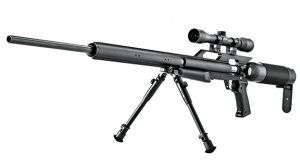
Source: (Depot, 2020)
AirForce Air guns (Figure 5.22) says this is the most powerful production air rifle in the world. It shoots .45-caliber lead projectiles at up to 1,000 fps for over 500 foot-pounds of energy. This is a single-shot, precharged pneumatic with a sidelever action and a 490-cubic-centimeter pressure tank equipped with a built-in pressure-relief device. It will effectively contain up to 3,000 psi of pressure. (Larson, 2015)
Several calibers of air rifles are being manufactured and many of the States are allowing hunting with these air guns. Calibers range from .177, .22, .25, .30, .338, .45, .50. There are .25 caliber guns that can shoot up to 60 times before needing a charge. Air guns you could argue are in their infancy much like the early musket muzzle loading guns. As materials, design, and projectiles improve its anyone guess to the level of quality, accuracy, and stopping power these forms of weapons could achieve.
Figure 5.23 Hatsan Big Bore Carnivore
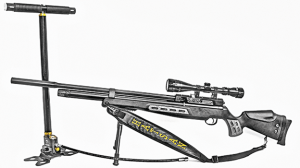
Source: (Depot, 2020)
Figure 5.24 Whitetail with an Airgun
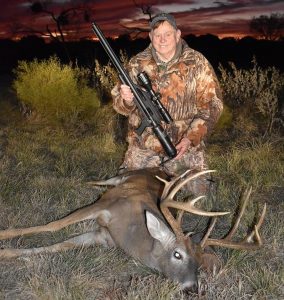
Source: (Clayton, 2019)
A 45 caliber Airforce Air guns Texan air rifle on the Dale River Ranch (www.daleriverranch.com) to harvest a whitetail buck with an air rifle. (Clayton, 2019)
The air rifle may not be the only firearm that totally disrupts the powdered firearm industry. A new kid is on the block and he is definitely in his infancy but shows beautiful room for improvement that would definitely be at its matchlock stage. What gun am I referring to you may wonder!! The hand-held coil gun. This gun is definitely in its infancy. Even though this gun appear to bigger and bulker, it tends to be lighter. That is because it is not slinging around bunches of weight from the cartridge ammo. Thanks to lead being too heavy. However, the coil gun makes some weight up with coils that are heavy. (See Figure 5.25)
Figure 5.25 Coil gun
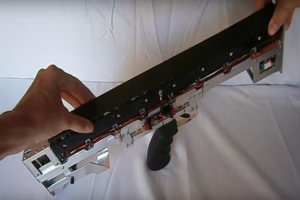
Source: (YouTube, 2021)
Conclusions
Since 2020 ammunition has become less available for all calibers in all places. Retailers, in store and online have seen less and less ammunition come into theirs stores. The manufactures have claimed to step up their operations. But it seems to still be getting worse. The claim is the COVID, safety fears, hording, administration changes, increased gun ownership is having something to do with the lack of availability. It may not be the agenda, but the hard reality is that by not keeping the store shelfs stocked it has the effect of disarming the American public. And let’s not forget the incoming administration has been noted for saying they want to take the guns away. Whatever the situation really is, people dedicated to having guns will switch to using something as air rifles. If they then try to regulate air, the author will have to claim that the desire to disarm the American public was the desire from the beginning. So rather than the air guns being the disruption, the government is the true disrupter.
Questions
- What basic components and tools are necessary to load you own ammunition?
- What would be necessary to build a small factory, secure the basic materials and manufacture ammunition at less than 50% of the market price. Develop the economic business model and consider the regulatory and public responses. Consider risks. Consider expected profit and market share.
- What legal / international / ATF road blocks must be hurdled to import components not readily available as surplus or recycled materials?
References
Author, W. (2020, September 7). Wikipedia. Retrieved from Flintlock: https://simple.wikipedia.org/w/index.php?title=Flintlock&oldid=7100109.
BackCountry Chronicles . (n.d.). BackCountry Chronicles. Retrieved 2021, from Choosing a Modern Bullet for your Modern Muzzleloader: https://www.backcountrychronicles.com/muzzleloader-bullets/
Benko, R. (2013, March 11). 1.6 Billion Rounds Of Ammo For Homeland Security? It’s Time For A National Conversation. Retrieved from forbes.com: https://www.forbes.com/sites/ralphbenko/2013/03/11/1-6-billion-rounds-of-ammo-for-homeland-security-its-time-for-a-national-conversation/?sh=1152e4f4624b
Clayton, K. J. (2019, November 15). Ketr. Retrieved from All things considered: https://www.ketr.org/post/lukes-first-whitetail-airgun
contributors, W. (2021, January 9). Paper cartridge. Retrieved from Wikipedia: https://en.wikipedia.org/wiki/Paper_cartridge
contributors, W. (2021, January 3). Breechloader. Retrieved from Wikipedia: https://en.wikipedia.org/wiki/Breechloader
Depot, A. (2020, December 31). Airgun Deport. Retrieved from What is the most powerful Airgun: https://www.airgundepot.com/vault/author/admin/
Harrington, H. T. (2013, July 15). Revolution, Journal of the American. Retrieved from All things Liberty: https://allthingsliberty.com/2013/07/the-inaccuracy-of-muskets/
II, J. H. (2017, October 30). What happens if you put a bullet into a gun backwards? Retrieved from Quora: https://www.quora.com/What-happens-if-you-put-a-bullet-into-a-gun-backwards
Ingraham, C. (2016, June 13). Economic Policy. Retrieved from The Washington Post: https://www.washingtonpost.com/news/wonk/wp/2016/06/13/the-men-who-wrote-the-2nd-amendment-would-never-recognize-an-ar-15/
Jeff. (2020, October 28). Best Deer Rifles. Retrieved from Big Game Logic: https://biggamelogic.com/deer-rifles/
Keefe, M. (2020, December 15). The Keefe Report: Where’s All The Ammo? Retrieved from www.americanrifleman.org/: https://www.americanrifleman.org/articles/2020/12/15/the-keefe-report-wheres-all-the-ammo
Kolander, J. R. (2016, April 1). RockIslandauction. Retrieved from Gun Blog: https://www.rockislandauction.com/riac-blog/what-is-a-wheellock-mechanism
Larson, D. (2015, December 15). Most powerful air-guns. Retrieved from Tactical-Life: https://www.tactical-life.com/firearms/10-of-the-most-powerful-airguns/
Madison, J. (1791). Bill of Rights Institute. Retrieved from Primary sources: https://billofrightsinstitute.org/primary-sources/bill-of-rights
Martin, G. (1761 (first Citation) 2021, January 7). The meaning and origin of the expression: Go off at half-cock. Retrieved from The Phrase Finder: https://www.phrases.org.uk/meanings/half-cocked.html
Netflix. (2021, January 10). Modern Warfare: The Korean War. Retrieved from Netflix: www.netflix.com
Sagi, G. (2021). 123rf. Retrieved from empty shell 15885089: https://www.123rf.com/photo_15885089_empty-shell-being-ejected-from-a-semi-automatic-handgun.html
SIMMONS, M. (2020, December 3). Gun advice. Retrieved from Rimfire vs. Centerfire Ammunition – Which Is Best?: https://www.gunadvice.com/rimfire-vs-centerfire-ammunition/
Tait, B. (2021, January 9). News. Retrieved from KSL TV: https://ksltv.com/452788/hundreds-of-people-line-up-outside-gun-store-in-orem/
Wallace, J. S. (2018). History of Gunpowder. In Chemical Analysis of Firearms, Ammunition, and Gunshot Residue (2nd ed., pp. 13-14). CRC Press.
Wiki Dictionary. (2021, January 11). Definition of Infringed. Retrieved from en.m.wikipedia.org: www.en.m.wikipedia.org/wiki/infringment
YouTube. (2021, January 13). Black powder. Retrieved from www.youtube.com: https://www.youtube.com/watch?v=aAgxI4fHL80
YouTube. (2021, January 10). Coil gun. Retrieved from www.youtube.com: https://www.youtube.com/watch?v=TWeJsaCiGQ0
YouTube. (2021, January 13). Smokeless Powder. Retrieved from www.youtube.com: https://www.youtube.com/watch?v=aAgxI4fHL80
Youtube. (2021, January 10). What bullets to use in your Muzzle loader. Retrieved from www.youtube.com: https://www.youtube.com/watch?v=B0djX76p4oE
Zent, J. (2020, December 17). American Rifleman. Retrieved from News: www.americanrifleman.org
[1] The word Infringed means “act so as to limit or undermine (something); encroach on” and “actively break the terms of (a law, agreement, etc.) (Wiki Dictionary, 2021)

